Automakers and Tier-Ones Make 2013 CES More
2013/04/10 | By Quincy LiangThe 2013 International Consumer Electronics Show (CES) was held on January 8 to 11 in Las Vegas, Nevada. The show attracted more than 3,250 exhibitors and covered 1.9 million square feet of exhibit space, breaking records on both counts. This year's event also underscored a clear upward trend in the number of automakers and tier-one auto-parts suppliers at the event to showcase innovations developed in conjunction with the demand for higher-tech, safer, more connected vehicles.
The strong turn-out of automakers and auto parts makers at information and communication technology (ICT) and consumer-electronics events like CES is expected to continue in the coming years as vehicles as technologies emerge to link home and office.
Technologies Transforming Future of Auto Industry
Show organizer, the Consumer Electronics Association (CEA), announced that a record number of automotive manufacturers exhibited at the 2013 International CES. Seven of the top-10 international car manufacturers showcased their latest technologies on the CES show floor, including Audi, Chrysler, Ford, General Motors, Hyundai, Kia and Subaru.
"The record number of top automotive manufacturers exhibiting in 2013 verifies that CES is the leading event for experiencing the latest in automotive innovation and in-vehicle electronics," said Gary Shapiro, president and CEO of CEA. "With major exhibits in the Las Vegas Convention Center's (LVCC) North Hall, as well as outdoor exhibits and demonstrations in Central Plaza, the 2013 CES show floor will feature a compelling display of the technologies transforming the future of the auto industry."
Automotive exhibits at International CES covered more than 100,000 net square feet of exhibit space in 2013, up 5% over the 2012 show. More than 110 total automotive tech companies, including Delphi, Mitek, and Pioneer, displayed their latest automotive technologies and services.
CEA predicts that sales of factory-installed vehicle technologies will increase by 11.3% in 2013 to nearly US$8.7 billion. Connected systems like OnStar and Ford SYNC offer infotainment, communication, safety and driver assistance solutions and services. CEA consumer research shows that approximately 15% of U.S. households now own a vehicle with a connected communication/entertainment system. CEA expects this figure to rise quickly in the coming years as car companies make these solutions available across more models.
The 2013 International CES featured two zones based on today's latest automotive technology. The GoElectricDrive TechZone, sponsored by the Electric Drive Transportation Association in the North Hall of the LVCC, showcased electric drive technologies, products and services. Electric vehicles (EVs) and their associated charge stations – for homes, condominiums, public facilities – and a range of electric mobility products and services were on display. The Safe Driver TechZone in the Las Vegas Hotel (LVH) focused on technologies that empower drivers to use their in-vehicle electronics in a safe and responsible way. Featured products assist in auto collision avoidance, lane drift assistance, parking, speed monitoring, hands-free, text-to-voice, driver drowsiness detection, GPS, mapping technologies and more.
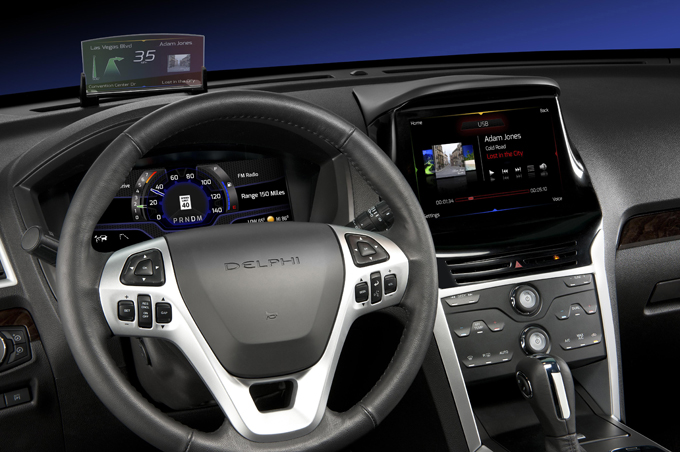
Delphi
One of the tier-one auto parts suppliers that showcased its latest technologies and products was Delphi Automotive, which announced a range of powerful connectivity, infotainment, safety and wireless-device charging technologies.
The Delphi technologies are designed to help driver's focus on driving while connecting in new ways for communication and fun. Delphi enables this driving experience through several advancements: first, through smart, active safety that places all critical information in the driver's forward view through a high-mount display, controlled at the steering wheel or by voice; second, by maximizing and extensively integrating in-vehicle computing power for easy and flawless entertainment and navigation capabilities through a Connected Navigation Radio; third, by allowing drivers to track, locate, access, secure and diagnose their vehicle anywhere at any time with a smart device or browser; and fourth, through wireless, automatic charging for smartphones, tablets and portable navigation devices that fully charge each of these with flexibility of placement within the vehicle.
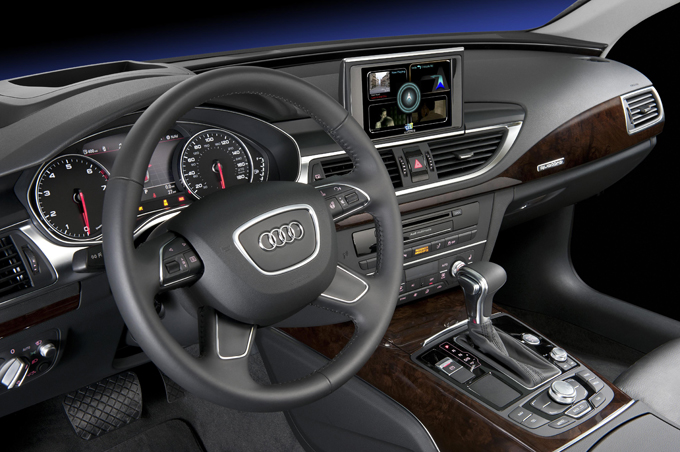
Delphi's latest contributions to automotive safety, connectivity and power were embodied in the technologies demonstrated at CES, including MyFi Connecting with Safety, MyFi Maximum Computing Power, Delphi's Connected Car, the magnetic-resonance-based wireless charging system and a portfolio of products that offer fast and comprehensive connectivity.
To reduce distractions and help drivers stay focused on the road, Delphi's MyFi Active Safety human-machine interface (HMI) controls the display of all important information within the driver's field of view, with the ability to control all major functions by the touch of a button on the steering wheel or by voice recognition. Helping drivers keep "eyes forward," the high-mount, transparent display has reconfigurable clusters that keep critical data in the driver's line of view at all times. Delphi's driver state sensor and workload manager deliver information in a safe manner, while actively conditioning the driver to focus and passively minimizing distraction. The technology proactively adjusts features based on real-time conditions. For example, MyFi monitors traffic conditions and the driver's incoming text messages; but if traffic is heavy and the driver needs to focus, Active Safety will not read the messages aloud.
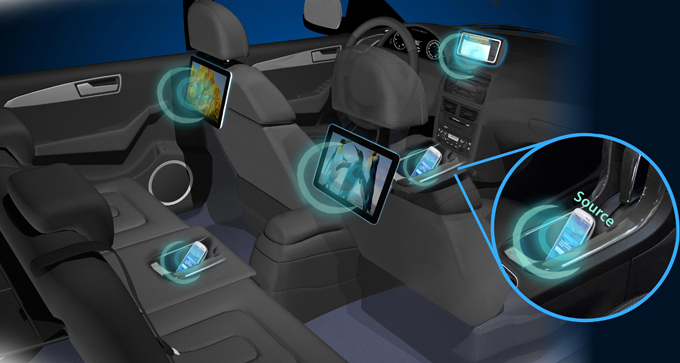
Connected Navigation Radio
Delphi has developed a Connected Navigation Radio, a highly integrated infotainment platform designed to offer increased connectivity and navigation features to the consumer. The Delphi Connected Navigation Radio is an embedded system that is rich in features, offering vehicle manufacturers the opportunity to differentiate their cars and trucks with the flexibility of individualized entertainment, information and communication. The radio's features include: the ability to synchronize with the portable devices of drivers and passengers; full-color map navigation; and flexible entertainment options, such as AM/FM, digital and high-definition radio.
Connected Car
Delphi also developed a device that provides a groundbreaking car-to-cloud/cloud-to-car connectivity service, allowing drivers to track, locate, access, secure and monitor their family's vehicles anywhere at any time with a smartphone or browser. The first-in-its-class device works in nearly every vehicle sold in the U.S. from 1996 onward.
The Delphi car connectivity system enables drivers to carry out any of the following features remotely: monitor overall vehicle status, highlight vehicle fault codes, locate and access a family's cars anywhere and anytime, receive alerts for driving and vehicle performance, set up geo-fences, and receive alerts for entry and exit, live tracking, trip logs, fast and cloud-connected response to key fob commands, and direct smartphone connect to vehicle via Bluetooth.
Wireless Charging for Consumer Devices
Delphi's Wireless Charging for consumer devices exhibited at 2013 CES can automatically transfer power to mobile electronic devices without cords, plugs or adapters, providing a safe and convenient way to charge devices. Wireless-charging technology transfers electric power over short distances without physical contact.
Delphi's Wireless Charging requires no cables or pads and charges multiple devices at a rate comparable to that of most residential plug-in chargers. The hands-free system will activate the moment a device is within range and is engineered to provide a safe, robust and fast charge.
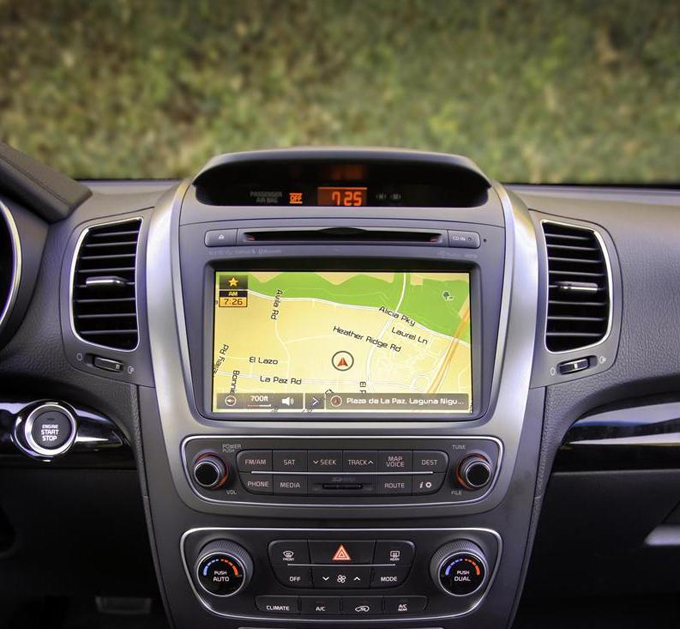
Hyundai Upgrade Blue Link and UVO with Google Maps
South Korean automakers Hyundai and Kia announced at 2013 CES they are adding Google Maps application programming interfaces (API) functionality to the telematics offerings from each brand within the Hyundai group.
Hyundai says Google Maps APIs will be integrated into the U.S.-based Hyundai Blue Link telematics platform, helping drivers more easily and quickly find their destination.
Kia Motors America also announced it would be working with Google to provide content and search-based solutions enabled by Google's APIs for the second-generation of the automaker's innovative UVO eServices telematics system.
Hyundai Blue Link currently offers a variety of features and applications that elevate the driving experience by providing connectivity, convenience and safety solutions. New features supported by the integration of Google Maps APIs include Send to Car, Point of Interest Search and Local Search by Voice.
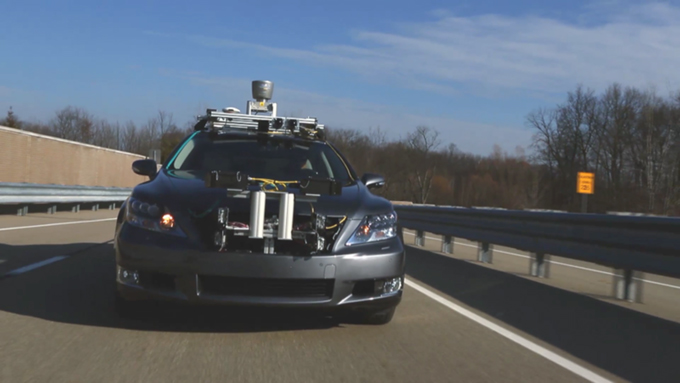
Toyota Reveals AASRV
Toyota Group used the 2013 CES to reveal an advanced active safety research vehicle (AASRV). The demonstration is based on a North American active safety program covering both Lexus and Toyota models. Technologies include the use of autonomous driving and high-level driver assistance systems based on Toyota Motor's Integrated Safety Management Concept.
Toyota is also promoting its intelligent transport systems (ITS) research and development activities, which include vehicle-to-vehicle (V2V) and vehicle-to-infrastructure (V2I) communications technology.
Toyota's AASRV prototype vehicle is a Lexus LS 600h fitted with radar and camera equipment that can detect other vehicles, road lane lines and traffic signals, giving the vehicle the ability to navigate streets without a driver. It also includes what appears to be the same roof-mounted laser that Google Inc. has been using on its autonomous research cars. Google began testing self-driving cars in 2009.
While Google uses many Toyota vehicles in its autonomous fleet, the two companies confirmed that Toyota's technology wasn't the result of a partnership, and that each firm is developing driving systems independently.
Industry sources say that building-block technologies at the heart of self-driving vehicles already exist widely, but automakers have been cautious in adding tools that could take the responsibility out of the hands of drivers. For instance, adaptive cruise control, available in dozens of vehicles on the market, can allow people to steer their vehicle and avoid touching the brake or accelerator on long trips. Daimler AG's Mercedes-Benz is working on technology for its S-class sedan that will handle braking and accelerating in stop-and-go traffic.
Besides Audi and Mercedes-Benz, other carmakers are also aggressively developing autonomous driving technology as well.
Audi, Qualcomm Show In-car LTE technology
Audi showed a 2013 Audi A3 model with 4G LTE wireless connectivity at the 2013 CES show.
The Audi LTE solution is based on the second generation Gobi multi-mode 3G/4G LTE chipset from Qualcomm Technologies. With peak data rates approaching 100 megabits per second, the enhanced "Audi connect" services in the A3 are expected to transform the user experience and provide enhanced features such as an in-car Wi-Fi hotspot, Internet radio, web services and an augmented navigation system that presents street level visual imagery streamed to the vehicle.
The solution will power Audi connect with 4G LTE speeds and is designed to enable enhancements to real-time navigation, weather and travel information while providing ultra-fast Wi-Fi hotspot access for up to eight devices in the car.
Qualcomm says it has been embedding its Gobi technology with leading automakers for more than a decade and claims it is currently the largest supplier of 3G and 4G technologies and chipsets for passenger-car telematics and connected-car services, with tens of millions of connected vehicles in operation worldwide.
TI Launches 2 New Technologies
Texas Instruments (TI), the largest semiconductor maker worldwide, launched two new technologies at the annual consumer-electronic show: the Jacinto 6 and digital light processing (DLP) freeform interactive display concept.
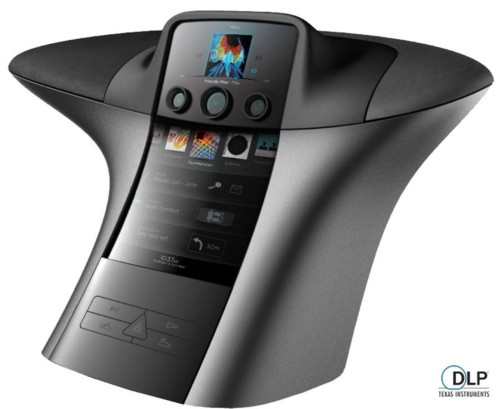
"Jacinto 6" is the code name for a new DRA74x processor built on TI's OMAP 5 architecture to optimize automotive solutions, adding audio, analytics and radio accelerators, along with automobile interfaces and peripherals. Integrating automotive interfaces with the processor architecture can decrease an automotive infotainment customer's electronic bill of materials (BOM) by up to 25% or more, while delivering best-in-class performance capabilities, TI says.
Texas Instruments also revealed its latest vision for the future of in-car/vehicle infotainment with groundbreaking augmented reality (AR) head-up displays (HUDs), digital dashboards, and center console systems enabled by TI DLP technology. These next-generation systems mark TI DLP's first official entry into the automotive industry, and represent a notable shift forward with regards to higher resolution and brightness, expanded field of view, tactile feedback, distraction-reduced functionality, and interior design flexibility that breaks the design barriers of existing technology.
With the unique micromirror structure of DLP technology, TI has been able to develop a compact HUD system with higher brightness and clarity in driving situations, a much wider field of view, and increased color reproduction over other display types.
Software-based augmented reality elements, such as navigational indicators, real-time landmark details, and safety warnings, can be shown in relation to real-world objects in view to help drivers stay focused on the road. Additionally, the size of the HUD image can be adjusted and positioned on the windshield to best match the line of vision depending on seating position to help the driver stay focused and alert.

